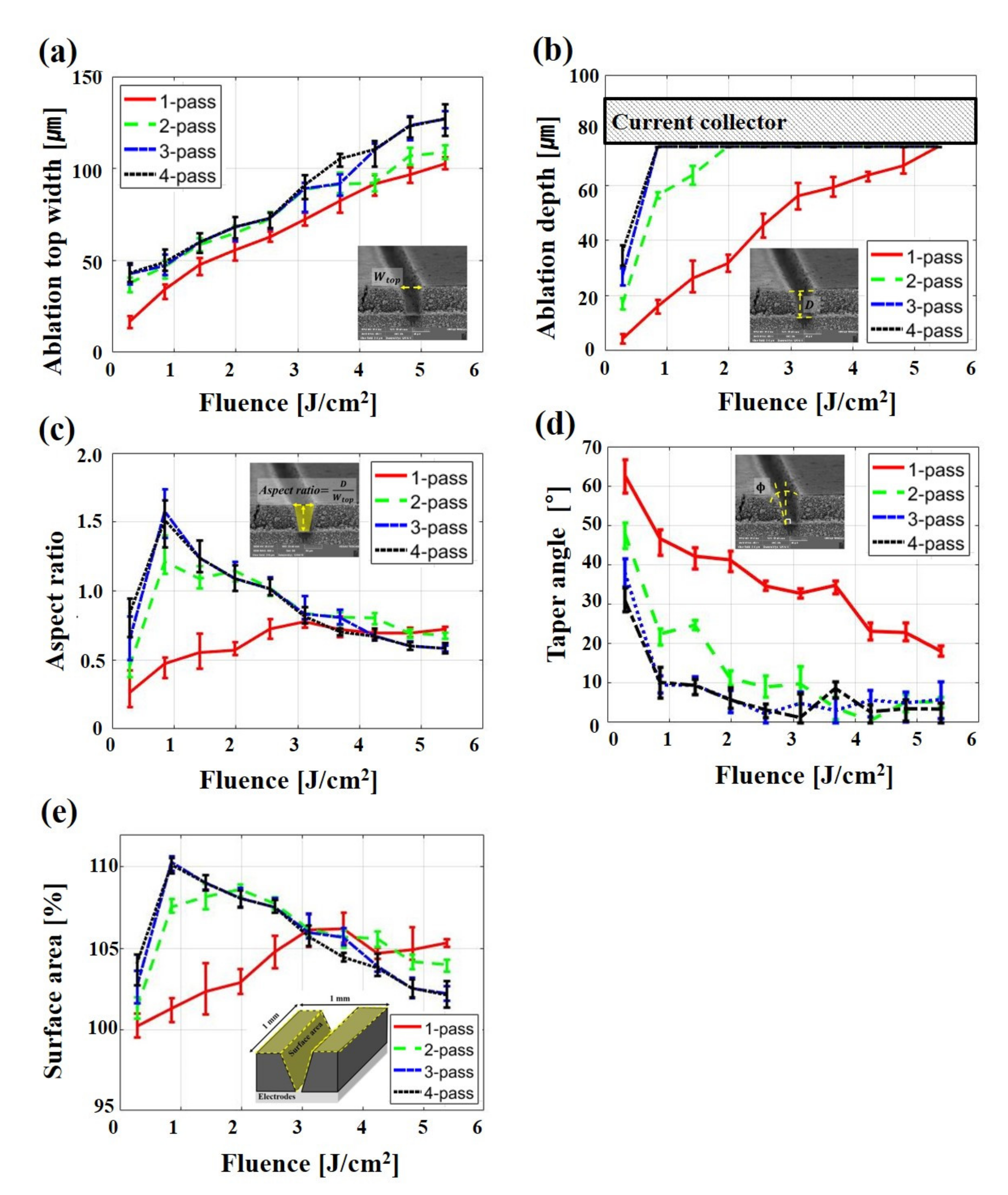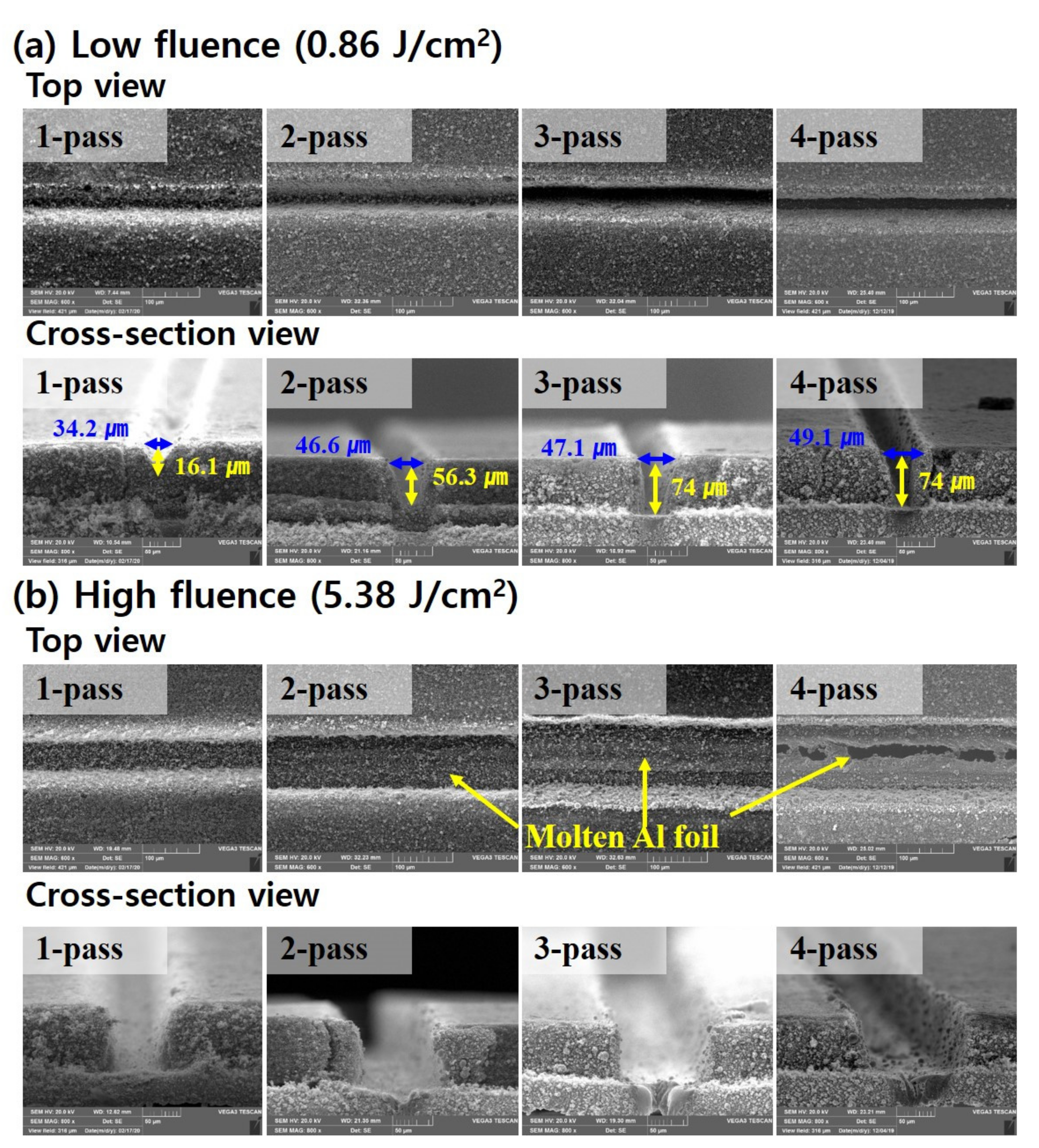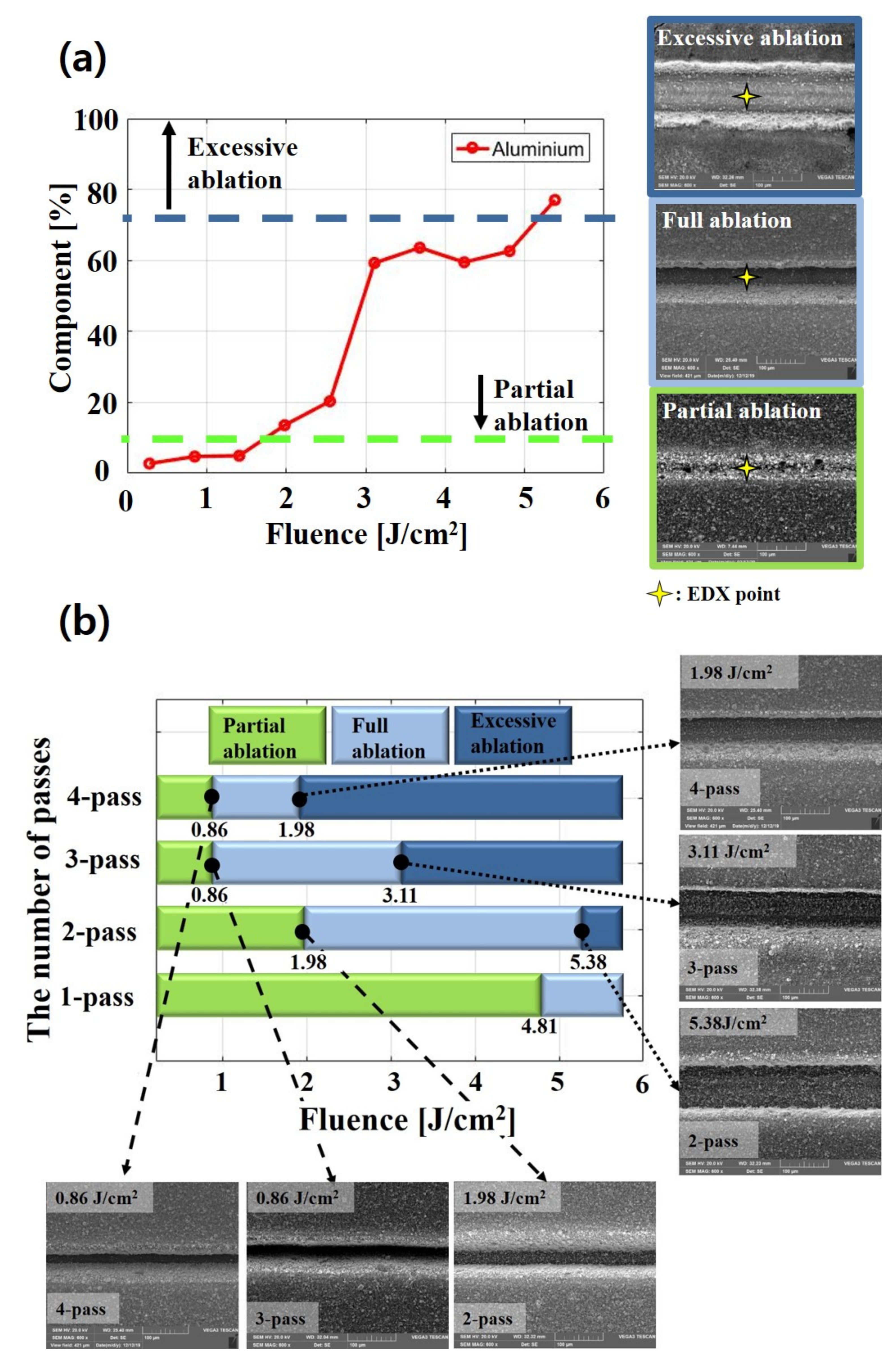Effect of Fluence and Multi-Pass on Groove Morphology and Process Efficiency of Laser Structuring for 3D Electrodes of Lithium-Ion Batteries
Abstract
:1. Introduction
2. Experimental Setup
2.1. Design of Electrodes
2.2. Laser Processing
2.3. Measurements
3. Results and Discussion
3.1. Groove Morphology Analysis
3.2. Classification of the Ablation Region
3.3. Amount of Material Removal (AMR) and Material Removal Rate (MRR)
4. Conclusions
- The groove in electrodes is formed widely and deeply as the fluence and the number of passes increase. The maximum aspect ratio of 1.58 is achieved at three passes and a fluence of 0.86 , increasing the surface area by approximately 10% more than that of unstructured electrodes.
- When increasing the number of passes with a relatively low fluence of 0.86, it is easy to form a groove with a high aspect ratio. On the other hand, as multi-pass with a relatively high fluence of 5.38 is applied, a groove with a lower aspect ratio is formed and the current collector is damaged.
- The ranges of the aluminum content which are detected in partial ablation, full ablation, and excessive ablation are from 2.75% to 4.95%, from 13.55% to 63.59%, and 77.04% and more, respectively. As the laser scan increases, excessive ablation occurs with relatively low fluence.
- The higher fluence and multi-pass lead to more reduced active material during laser structuring. The MRR is significantly different according to the combination of fluence and the number of passes. Considering both the AMR and MRR at the same time, low fluence and multi-pass in the laser structuring of electrodes are assumed to be effective.
Author Contributions
Funding
Institutional Review Board Statement
Informed Consent Statement
Data Availability Statement
Conflicts of Interest
References
- Nitta, N.; Wu, F.; Lee, J.T.; Yushin, G. Li-ion battery materials: Present and future. Mater. Today 2015, 18, 252–264. [Google Scholar] [CrossRef]
- Zubi, G.; Dufo-López, R.; Carvalho, M.; Pasaoglu, G. The lithium-ion battery: State of the art and future perspectives. Renew. Sustain. Energy Rev. 2018, 89, 292–308. [Google Scholar] [CrossRef]
- Ou, J.; Yang, L.; Jin, F.; Wu, S.; Wang, J. High performance of LiFePO4 with nitrogen-doped carbon layers for lithium ion batteries. Adv. Powder Technol. 2020, 31, 1220–1228. [Google Scholar] [CrossRef]
- Jian, Z.; Wang, W.; Wang, M.; Wang, Y.; Auyeung, N.; Liu, M.; Feng, Z. Al2O3 coated LiCoO2 as cathode for high-capacity and long-cycling Li-ion batteries. Chin. Chem. Lett. 2018, 29, 1768–1772. [Google Scholar] [CrossRef]
- Zheng, H.; Li, J.; Song, X.; Liu, G.; Battaglia, V.S. A comprehensive understanding of electrode thickness effects on the electrochemical performances of Li-ion battery cathodes. Electrochim. Acta 2012, 71, 258–265. [Google Scholar] [CrossRef]
- Pfleging, W. A review of laser electrode processing for development and manufacturing of lithium-ion batteries. Nanophotonics 2018, 7, 549–573. [Google Scholar] [CrossRef]
- Habedank, J.B.; Schwab, D.; Kiesbauer, B.; Zaeh, M.F. Paving the way for industrial ultrafast laser structuring of lithium-ion battery electrodes by increasing the scanning accuracy. J. Laser Appl. 2020, 32, 022053. [Google Scholar] [CrossRef]
- Zhu, P.; Seifert, H.J.; Pfleging, W. The ultrafast laser ablation of Li(Ni0.6Mn0.2Co0.2)o2 electrodes with high mass loading. Appl. Sci. 2019, 9, 4067. [Google Scholar] [CrossRef] [Green Version]
- Lee, D. Investigation of Physical Phenomena and Cutting Efficiency for Laser Cutting on Anode for Li-Ion Batteries. Appl. Sci. 2018, 8, 266. [Google Scholar] [CrossRef] [Green Version]
- Jansen, T.; Kandula, M.W.; Hartwig, S.; Hoffmann, L.; Haselrieder, W.; Dilger, K. Influence of Laser-Generated Cutting Edges on the Electrical Performance of Large Lithium-Ion Pouch Cells. Batteries 2019, 5, 73. [Google Scholar] [CrossRef] [Green Version]
- Kronthaler, M.; Schloegl, F.; Kurfer, J.; Wiedenmann, R.; Zaeh, M.; Reinhart, G. Laser Cutting in the Production of Lithium Ion Cells. Phys. Procedia 2012, 39, 213–224. [Google Scholar] [CrossRef] [Green Version]
- Lutey, A.H.; Fortunato, A.; Carmignato, S.; Fiorini, M. High speed pulsed laser cutting of LiCoO2 Li-ion battery electrodes. Opt. Laser Technol. 2017, 94, 90–96. [Google Scholar] [CrossRef]
- Zhang, Y.; Li, J.; Yang, R.; Liu, T.; Yan, Y. Analysis of kerf quality on ultrafast laser cutting of anode material for lithium-ion battery. Opt. Lasers Eng. 2019, 118, 14–21. [Google Scholar] [CrossRef]
- Schmitz, P.; Habedank, J.B.; Zaeh, M.F. Spike laser welding for the electrical connection of cylindrical lithium-ion batteries. J. Laser Appl. 2018, 30, 012004. [Google Scholar] [CrossRef]
- Lee, D.; Mazumder, J. Effects of momentum transfer on sizing of current collectors for lithium-ion batteries during laser cutting. Opt. Laser Technol. 2018, 99, 315–325. [Google Scholar] [CrossRef]
- Jansen, T.; Kandula, M.W.; Blass, D.; Hartwig, S.; Haselrieder, W.; Dilger, K. Evaluation of the Separation Process for the Production of Electrode Sheets. Energy Technol. 2020, 8. [Google Scholar] [CrossRef] [Green Version]
- Trinh, L.N.; Lee, D. The Characteristics of Laser Welding of a Thin Aluminum Tab and Steel Battery Case for Lithium-Ion Battery. Metals 2020, 10, 842. [Google Scholar] [CrossRef]
- Lee, D.; Patwa, R.; Herfurth, H.; Mazumder, J. Parameter optimization for high speed remote laser cutting of electrodes for lithium-ion batteries. J. Laser Appl. 2016, 28, 022006. [Google Scholar] [CrossRef]
- Park, J.; Hyeon, S.; Jeong, S.; Kim, H.J. Performance enhancement of Li-ion battery by laser structuring of thick electrode with low porosity. J. Ind. Eng. Chem. 2019, 70, 178–185. [Google Scholar] [CrossRef]
- Mangang, M.; Seifert, H.; Pfleging, W. Influence of laser pulse duration on the electrochemical performance of laser structured LiFePO4 composite electrodes. J. Power Sources 2016, 304, 24–32. [Google Scholar] [CrossRef]
- Luetke, M.; Franke, V.; Techel, A.; Himmer, T.; Klotzbach, U.; Wetzig, A.; Beyer, E. A Comparative Study on Cutting Electrodes for Batteries with Lasers. Phys. Procedia 2011, 12, 286–291. [Google Scholar] [CrossRef]
- Porneala, C.; A Willis, D. Time-resolved dynamics of nanosecond laser-induced phase explosion. J. Phys. D Appl. Phys. 2009, 42. [Google Scholar] [CrossRef]
- Vlǎdoiu, I.; Stafe, M.; Neguţu, C.; Popescu, I.M. Nanopulsed ablation rate of metals dependence on the laser fluence and wavelength in atmospheric air. UPB Sci. Bull. Ser. A Appl. Math. Phys. 2008, 70, 119–126. [Google Scholar]
- Mohanty, D.; Hockaday, E.; Li, J.; Hensley, D.K.; Daniel, C.; Wood, D.L. Effect of electrode manufacturing defects on electrochemical performance of lithium-ion batteries: Cognizance of the battery failure sources. J. Power Sources 2016, 312, 70–79. [Google Scholar] [CrossRef] [Green Version]
- Raciukaitis, G.; Brikas, M.; Gecys, P.; Gedvilas, M. Accumulation effects in laser ablation of metals with high-repetition-rate lasers. High-Power Laser Ablation VII 2008, 7005, 70052L. [Google Scholar] [CrossRef]
- Lee, D. Understanding of BeCu Interaction Characteristics with a Variation of ns Laser-Pulse Duration. Materials 2018, 11, 1423. [Google Scholar] [CrossRef] [PubMed] [Green Version]







| Classification | Value |
|---|---|
| Active material | LiFePO4 (80 wt%) |
| Conducting agent | Super P (10 wt%) |
| Binder | Polyvinylidene fluoride (10 wt%) |
| Active material thickness | 90 μm → 74 μm |
| Current collector | Aluminum foil |
| Current collector thickness | 20 μm |
| Ytterbium Pulsed Fiber Laser (YLPM-1-4200-20-20, IPG) | Value |
|---|---|
| Fluence | 0.28~5.38 J/cm2 |
| Wavelength | 1064 nm |
| Pulse duration | 4 ns |
| Repetition rate | 500 kHz |
| Scanning speed | 500 mm/s |
| Pulse overlap | 96.67% |
| The number of passes | 1~4 passes |
Publisher’s Note: MDPI stays neutral with regard to jurisdictional claims in published maps and institutional affiliations. |
© 2021 by the authors. Licensee MDPI, Basel, Switzerland. This article is an open access article distributed under the terms and conditions of the Creative Commons Attribution (CC BY) license (http://creativecommons.org/licenses/by/4.0/).
Share and Cite
Park, D.; Lee, D. Effect of Fluence and Multi-Pass on Groove Morphology and Process Efficiency of Laser Structuring for 3D Electrodes of Lithium-Ion Batteries. Materials 2021, 14, 1283. https://doi.org/10.3390/ma14051283
Park D, Lee D. Effect of Fluence and Multi-Pass on Groove Morphology and Process Efficiency of Laser Structuring for 3D Electrodes of Lithium-Ion Batteries. Materials. 2021; 14(5):1283. https://doi.org/10.3390/ma14051283
Chicago/Turabian StylePark, Dongkyu, and Dongkyoung Lee. 2021. "Effect of Fluence and Multi-Pass on Groove Morphology and Process Efficiency of Laser Structuring for 3D Electrodes of Lithium-Ion Batteries" Materials 14, no. 5: 1283. https://doi.org/10.3390/ma14051283






